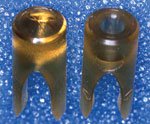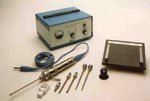Surgeon applies the science of medicine to the game of golf and publishes the results
The holder of more than 40 medical patents, Lanny L. Johnson, MD, focused on helping golfers improve their putting technique with a book released in 2010.
Click Here to Manage Email Alerts
Retired orthopedic surgeon Lanny L. Johnson, MD, has shifted some of his focus and drive from medicine to another of his passions: golf. For the past 6 years, he has used scientific methods to study the art of putting, and in December 2010 published his findings in a 550-page book, There is More to Putting than Meets the Eye. Co-authored by golf pro Howard Twitty, the book chronicles Johnson’s analysis of putting strokes in approximately 200 Professional Golfers’ Association (PGA) golfers.
Well-known for his pioneering work in arthroscopic surgery, Johnson has invented and patented more than 40 surgical instruments, systems and techniques. He identified one of his first arthroscopic devices, the motorized shaver, as his most notable invention. Johnson told Orthopedics Today it was patented in 1978 and “is still probably the most commonly used instrument in orthopedics outside of a hammer everyday worldwide.”
Other patents Johnson received for surgical instruments included a clamping device, an arthroscopic ligamentous and capsular fixation system, a metal surgical staple and a surgical suture snagging method and several arthroscopic abrading instruments. To market his ideas and designs, Johnson founded Instrument Makar in 1980.
Instrument innovations
|
Images: Johnson LL |
Johnson said Instrument Makar served as an avenue to produce and sell his instruments, including a magnetic suction device to retrieve broken instruments in the knee, a series of small knife blades of various shapes and a clamp to secure the thigh during surgery that, like the shaver, also is still used today.
He sold Instrument Makar to Smith & Nephew in 2002.
Johnson attributed his motivation for developing arthroscopic instruments and refining surgical techniques to his curiosity and desire for things to be better.
“Before arthroscopy, the treatment with a 6-inch incision on the knee was worse than the small tear in the meniscus or ligament,” he said.
During the 1990s, Johnson continued designing and developing arthroscopic instruments, receiving patents for a fixation screw for ligament reconstruction, a bone grafter, several suture anchors, a mini-screw and a suture knot-making device. Johnson’s most significant patent during this period was for biodegradable surgical staples and screws. He is credited as one of the first surgeons to use biodegradable materials.
Arthroscopy pioneer
Many of Johnson’s patents also include methods for using his instruments. Johnson told Orthopedics Today that he often was the first to perform and report on arthroscopic procedures, such as shoulder reconstruction for dislocations and rotator cuff repair with his metal staple, and resection of the acromioclavicular joint by arthroscopy. Johnson recalled his pioneering arthroscopic exploration of joints other than the knee, including the thumb, wrist, elbow, shoulder, hip, ankle and toe, which he outlined in his 1986 book, Arthroscopic Surgery: Principles and Practice.
In addition, Johnson, who often taught these procedures to others, noted he was “the first to have a dedicated room for arthroscopic surgery with glass walls and bleachers for visitor viewing.”
Since retiring from clinical practice in 1995, Johnson has continued his efforts in orthopedic research and development. He received patents pertaining to arthroplasty, one for a prosthesis having wear particle collection capability and several others for hip arthroplasty instrumentation. Some of his most recent research centers on cartilage healing, and since 2000 he has received patents for an intra-articular drill, articular cartilage grafting instruments and a fixation device for fibrous tissue.
|
|
|
Applying science to sport
Ironically, Johnson noted that rotator cuff surgery served as the impetus for his book on putting. An avid golfer for most of his life, Johnson started thinking about putting when his recovery from shoulder surgery kept him off the golf course and wondered if there was a way he could apply some of the things he had done in medicine to golf putting.
Calling on his knowledge and experience as an orthopedic surgeon and inventor, Johnson set about investigating the design of putters, as well as the motor skills needed for putting.
“I analyzed putting in a way that nobody had ever looked at before, from the standpoint of how the body functions, like I was teaching motor skills — how do you hold an instrument, how do you triangulate, how do you palpate and all of those things,” Johnson said.
Collaborates with Twitty
Johnson’s credentials as a PGA Tour instructor allowed him access to professional golfers. He also met and became friends with Twitty, who offered encouragement. To collect and record putting data, Johnson purchased a SAM PuttLab machine, an ultrasound machine that records the putting stroke in 28 dimensions. Johnson, who likened the PuttLab to “an MRI machine for putting,” analyzed the data using his viewpoint as a doctor. He then compiled his findings in a book and asked Twitty, who Johnson describes as “one of the best all-time putters,” to be his co-author and write a “Twitty’s Takes” section for each chapter.
The book, which Johnson self-published, includes pre- and post-instruction putting graphs generated by the PuttLab that show where the player is aiming, where the putter path goes backwards and forwards, how much the putter rotates, the speed and change of speed of the putt, and its acceleration. Johnson compared the graphs to preoperative and postoperative radiographs of a broken arm.
|
|
|
“It would be like saying ‘I can look at your arm, but I cannot tell what kind of fracture you have or whether the bone is up or down, sideways or comminuted.’ With an X-ray or an MRI, I can tell you exactly what [fracture] it is,” he said, noting the book title reflects this concept of “seeing” beneath the surface.
According to Johnson, the stand-out part of his book is it includes information from a medical perspective on how the body functions, such as two-point discrimination or proprioception.
“Golfers all have to be great at proprioception innately, but they have never heard of that word,” he said. “What I have been doing is teaching surgery principles to professional golfers.” – Mary L. Jerrell, ELS
Reference:
- Johnson LL, Twitty H. There is More to Putting Than Meeting the Eye. Self-published; 2010. www.moretoputting.com.
- Lanny L. Johnson, MD, can be reached at PO Box 975, Okemos, MI 48805-0975; 760-930-1955; email: lljmd@aol.com.
- Disclosure: Johnson has no relevant financial disclosures.





